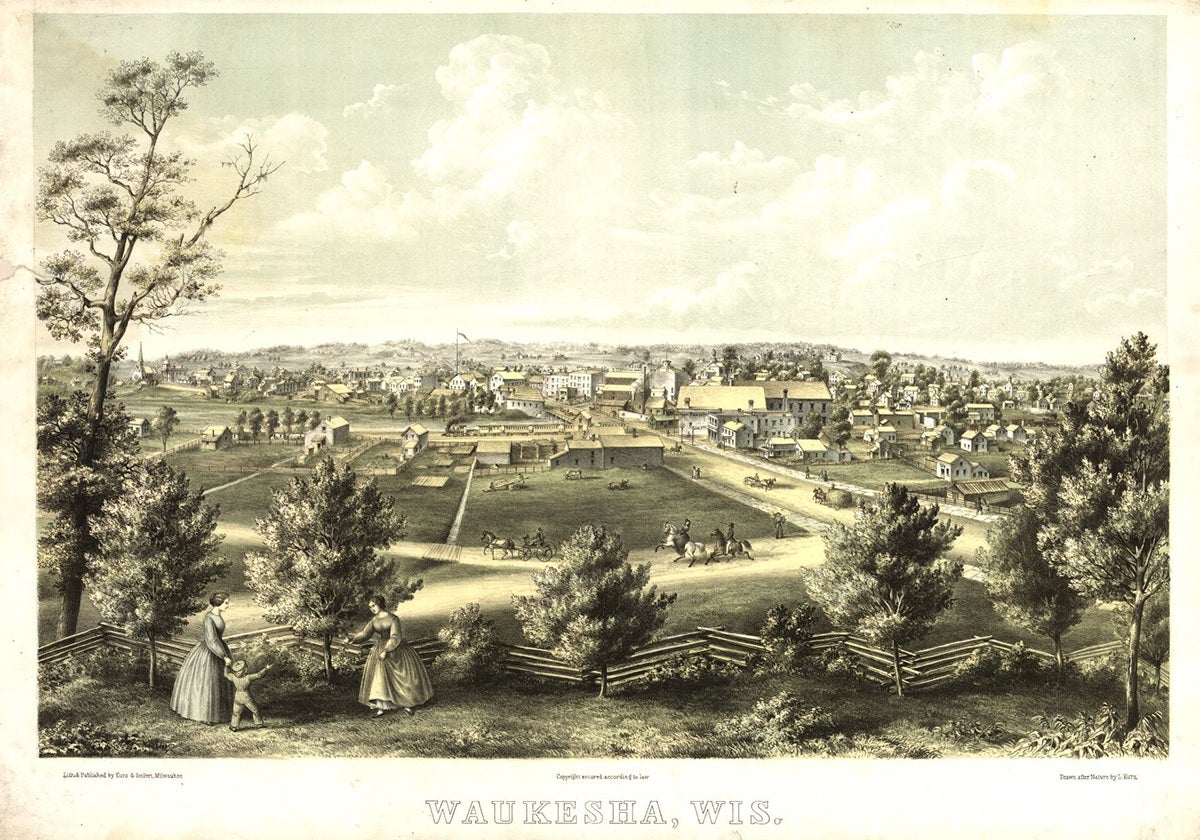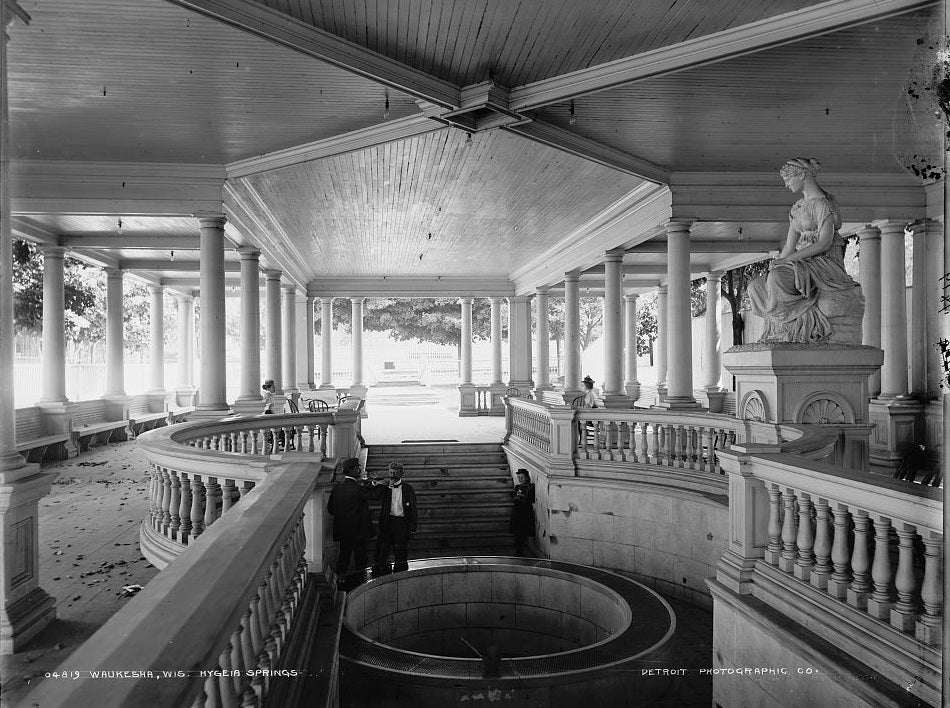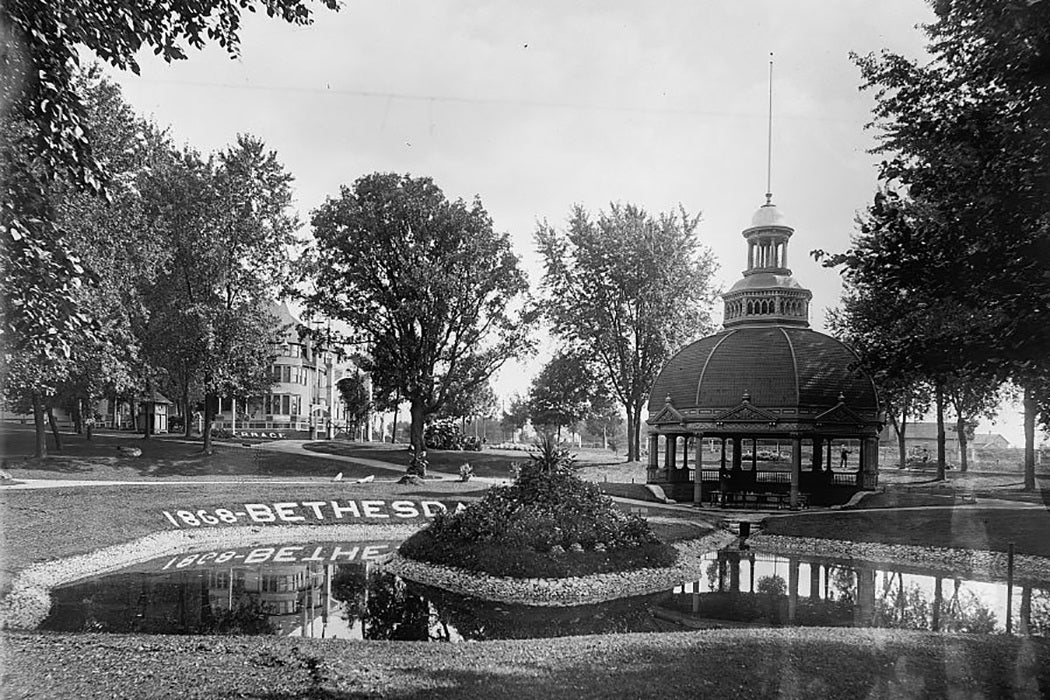Richard Dunbar, an Irish immigrant, is visiting his sister-in-law in Waukesha, Wisconsin. It’s 1868, and he is tired, so he rests near an oak tree. Weakened by diabetes, he suffers from one of its primary symptoms: polydipsia (excessive thirst). He is debilitated by thirst, whether caused by diabetes or just the heat of an August day, and so he drinks.
Dunbar, an impresario and entrepreneur, had other thirsts. He was an ambitious man, one who dared add the title of colonel to his name despite having no record of military service. He built railroads in America and then Cuba. He helped build Washington, D.C.’s first public water system, an aqueduct that diverted water from the Potomac River 12 miles downstream to the U.S. capital. Like the railroads, the aqueduct was an engineering marvel of its day.
But back to the oak tree where we left an exhausted Dunbar. His physician, the story goes, had sent him to the springs of Europe, but it was to no avail. Now he was back in the United States and near death. He was also near water—one of the plentiful cold mineral springs that dotted the area.
Water has always been part of Waukesha’s history. The city’s first white settlers, who came to the area about 30 years before the “Colonel,” recorded accounts of nearly 100 people of the Potawatomi Nation drinking, bathing in, and transporting water from local springs. Animals drank at springs, which meant abundant hunting opportunities; better yet, the springs offered plentiful water for humans. When settlers set up camp in Wisconsin, it was often near a spring, and Waukesha was no exception.

As for Dunbar and his endless thirst, dying for water, he sat down at an oak tree next and began to drink—six glasses of spring water, then more. Then even more. The spring, he claimed, did something for him. As long as he drank, he felt better. And when he went away, he told everyone he met, he suffered.
He named the spring Bethesda, a not-so-subtle Biblical reference to the miraculous pool where Jesus healed the sick. The mineral water he drank by the tumblerful may have alleviated his diabetes symptoms, but it didn’t alter the Colonel’s fundamental need to build wealth and fame. His sojourn to Waukesha turned into a permanent vacation, and he set out to monetize his discovery. Dunbar partially bought out his mother-in-law’s interest in the spring and began to spread news of its healing properties far and wide.
Not everyone was thrilled to find that their local spring was a magical one: Dunbar met with furious resistance in town from locals who accused him of lying about his cure, profiting off of their land, and doctoring the water itself, writes the historian David P. McDaniel. But Dunbar didn’t care.
Hopped up on spring water and hell-bent on publicizing his discovery, Dunbar waged his own kind of water war against the people of Waukesha. Despite the townspeople’s initial suspicion, he won. “[W]ith the aid of an aggressive local newspaper, small town boosterism, numerous claims of miracle cures by pilgrims from near and far, and… the Colonel’s own Barnumesque salesmanship,” McDaniel writes, Dunbar willed Waukesha from a sleepy village into a cultural phenomenon.
America already had a love affair with the supposed healing powers of water. Soon they fell in love with Waukesha, too. It gained the nickname “Spring City.” Spurred on by Dunbar’s aggressive entrepreneurialism, it quickly became a place to see and be seen.
By the time Dunbar died in 1878, Waukesha was a sensation. Vacationers from the East Coast headed to town to enjoy the waters, catch up on society gossip, luxuriate in newly built hotels, and summer on the Third Coast. Saratoga, New York, it seemed, had nothing on Waukesha. Even in death, Dunbar was vindicated. “Time, which makes all things even, had made Bethesda a victor,” he wrote.
His account is tucked into an 1880 historical society-penned paean to Waukesha that can’t bear to bypass a chance to laud its city’s beauty, history, and—of course—water.
Dunbar’s account of his amazing turnaround is couched in the language of health and healing. But something else creeps through his narrative—an uncomfortable touch of vengefulness and grandeur. “The voice of sneering incredulity was silenced; the healing properties of the spring were acknowledged,” he bragged. “I have been the means of enriching those miserable persecutors. I have snatched Waukesha from obscurity, and set it in a large place; its conspicuity is widening, as everybody can see.”
Everybody could see. They watched as water brought Waukesha its equivalent of the gold rush. Swiftly, the town morphed into a tourist mecca. The historian Lillian Krueger documents the popular reaction to the town’s transformation into “the Saratoga of the West:” An observer makes snarky comments about the rich accessories of visiting women. A vacationing millionaire decides to invest big in Waukesha hotels.
But 100 miles away, in Chicago, on the banks of Lake Michigan, an unseen force was about to reshape Waukesha’s history. It was Salmonella typhi, a bacterium that thrives in contaminated water. When ingested, it afflicts patients with a rash, weakness, and a dire fever. And in the late nineteenth-century, typhoid fever was Public Enemy No. 1.
Chicago had a big problem with typhoid. During the 1890s, the city was tasked with staging the World’s Columbian Exposition, a huge fair that celebrated the quadricentennial of Columbus’s arrival in the New World. Despite being supplemented with pumped-in Lake Michigan water, the Chicago River was contaminated with raw sewage that circulated typhoid. Fears about Chicago water threatened to tank the exhibition before it even began.
However, according to the historian Michael P. McCarthy, the city had an ace up its sleeve: Waukesha water. By the 1890s, water from Bethesda and other springs was already sold by the gallon throughout the region and “arrived daily in porcelain-lined tank cars” from Wisconsin.
The Second City needed fresh water, and Waukesha was overdue for an entrepreneur ready to take up Dunbar’s watery crown. James E. McElroy fit the bill just fine. He set his sights on one of Bethesda Spring’s competitors, Hygeia. He bought the Hygeia spring and set about turning it into a far-away drinking fountain for the Chicago fair.
An 1893 engineering magazine lays out the terms of McElroy’s ambitious contract with the fair: Water would gush from Waukesha to Chicago via iron pipe, be cooled by a special refrigerating plant, and then pumped directly to vendors and to 200 special water booths. McElroy would net 8.5 cents per gallon after commission—about $2.30 in 2017 dollars.
There was just one problem: Waukesha. The city had gulped down Dunbar’s obnoxious salesmanship for the sake of notoriety, but the pipeline plan was a step too far. Annoyed by plans to run ugly pipes through the resort town and worried that the plan to increase Hygeia’s output would reduce the flow at other springs, citizens acted quickly to stave off McElroy’s plan.
They fought McElroy in the boardroom and in court, even chartering a special train for their trip to Madison to fight the franchise. Undeterred, McElroy simply brought workers into Waukesha by cover of night to build the pipeline. But locals were prepared: An armed mob met him at the train station and ran him out of town.
Desperate, McElroy went to a town 12 miles away, but still within Waukesha County, and bought a spring there instead. The water was stale and tasteless by the time it made the 100-mile trip to Chicago. Despite accusations that he was ripping off Chicagoans with fake water, McElroy insisted that the water was from Waukesha. He eventually went bust.
In 1991, the oak tree where Dunbar supposedly drank his first glass of Waukesha spring water—by then a longtime local monument—fell down after a severe thunderstorm. At that point, Waukesha’s tourist mecca days were long gone. Spring water was no longer touted as a medicinal tonic, and the city’s most prominent water-related buildings had long since been torn down.
But trouble was bubbling beneath Waukesha—water trouble. The city had long since laid its tourism business to rest and turned to industry instead. Its ready supply of St. Peter sandstone—a silica rock that’s also used to make glass and industrial sand, which originates from the gigantic aquifer on which the city sits—made Waukesha attractive to foundries and other industrial enterprises. No longer dependent on water, Waukesha’s population surged as nearby Milwaukee grew.

As Waukesha morphed into a Milwaukee suburb, its remaining springs dried up, and locals began to drill into its aquifer for water. A century earlier, the springs’ disappearance would have crippled the tourism-dependent city, but now it had a water crisis to contend with. The more the city drilled, the more it depleted its groundwater. The less groundwater it had, the deeper the city drilled.
Today, the city of Waukesha Water Utility estimates, its groundwater levels drop between five and nine feet every year, and a shale layer that covers its aquifer prevents local water from collecting quickly enough to sustain the city’s thirst. In a state packed with more than 15,000 lakes, groundwater-dependent Waukesha couldn’t find enough to drink. By the time Dunbar’s Oak fell, groundwater levels were in free fall—and radium in local water was on the rise.
The radioactive element, discovered by Marie and Pierre Curie in 1898, occurs naturally in groundwater as rocks break down. Scientists have known that radium is carcinogenic since the 1920s, its dangers made horrifyingly evident by the ordeal of the “Radium Girls,” a group of women who contracted gruesome radium poisoning after painting wristwatches with radium-laced, glow-in-the-dark paint. The tragedy prompted workplace reforms and spurred federal regulation of the element.
Today, the United States Environmental Protection Agency requires communities to comply with national standards for radium levels in drinking water. But the deeper Waukesha’s wells went, the more radium showed up in its water supply. When the EPA moved to update its acceptable radium levels in 1991, the city fought back, waging an unsuccessful, 12-year-long lawsuit against the agency in an attempt to block the new rule.
When the city lost its legal battle, it changed course. This time, its target was an aboveground water source: Lake Michigan.
The same glacier that created all of the Great Lakes formed the city’s geography. Over 1.5 million years, lobe-like portions of the glacier melted and retreated. The gigantic lakes that resulted are surrounded by the sand that erosion and deglaciation left behind. But Waukesha does not border Lake Michigan, and though it’s only 20 miles away from the lake, it isn’t technically part of the Great Lakes drainage basin.
It’s also not legally entitled to the lake’s water. Since 2008, the lake has been subject to the Great Lakes Compact, an agreement between Great Lakes states and two Canadian provinces about how the lake’s water should be handled. Federal law prohibits diverting the lake’s water.
Unwilling to comply with new EPA radium regulations and stretched thin by continued population growth, Waukesha asked to become the exception to that rule. Drawing 10.1 million gallons per day from the lake, the city says in its application, is its “only reasonable alternative.”
Opponents consider Waukesha’s application—which was approved last year—a potential test for the compact. They say it will open the door to future challenges and potentially contaminate nearby areas with the treated wastewater the city plans to pump back into the lake.
Numerous attempts to stave off the proposal have failed, including an eleventh-hour bid by mayors from dozens of Canadian and American cities to stop the diversion. Meanwhile, Waukesha continues to grow faster than other cities in the Milwaukee metropolitan area, picking up more residents as people head for the suburbs.
For now, Waukesha is busy setting its diversion plans into motion and trying to assuage the worries of nearby communities that are unhappy at the prospect of having the city’s wastewater pumped down their streams. It’s not yet clear if proposed legal action to stop the diversion will move forward.
On the one hand, it seems that the Great Lakes have water to spare. Combined, the five lakes contain 95 percent of the United States’ surface fresh water—6 quadrillion gallons in all. But the city’s deal has yet to be truly tested, and it remains to be seen whether other radium-tainted Wisconsin cities will follow Spring City’s lead and ask for diversions of their own. For now, it’s unclear whether Waukesha’s bid will succeed—or whether its future holds yet another water war.







